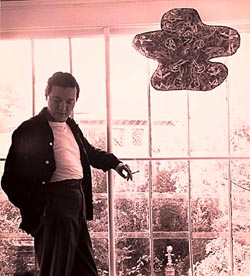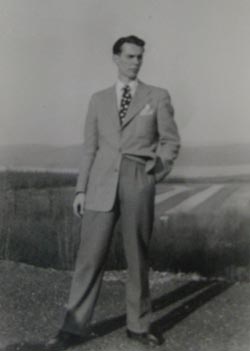| HOME MISSION STATEMENT ALFONSO OSSORIO CHRONOLOGY MUSEUM COLLECTIONS ANNOUNCEMENTS CONTACT copyright ©2022 |
O S S O R I O F O U N D A T I O N ALFONSO OSSORIO  When artist Alfonso Ossorio died at the
age of 74 on December 5th, 1990, he left
behind a remarkable legacy of art,
diaries, photographs, letters and other
historic materials documenting a lifetime
of artistic and cultural activity. Ossorio is
well known for his assemblages of
objects made between 1958 and 1984,
which he called "Congregations," as well
as his works on paper and paintings from
the 1930s through 1990. When artist Alfonso Ossorio died at the
age of 74 on December 5th, 1990, he left
behind a remarkable legacy of art,
diaries, photographs, letters and other
historic materials documenting a lifetime
of artistic and cultural activity. Ossorio is
well known for his assemblages of
objects made between 1958 and 1984,
which he called "Congregations," as well
as his works on paper and paintings from
the 1930s through 1990.Alfonso Ossorio is regarded as an important colleague of Jean Dubuffet and Jackson Pollock. He was an early collector of their work, as well as the work of Willem de Kooning, Lee Krasner and Clyfford Still, among others. Ossorio acquired The Creeks, a 60 acre estate designed by Grosvenor Atterbury on Georgica Pond in East Hampton, NY from the Herter family in 1952. In the upper rooms of the Italianate mansion, Ossorio maintained and exhibited Dubuffet's collecion of outsider art, called L'Art Brut, from 1952 to 1962. Later Ossorio created and developed a widely admired sculpture park and conifer arboretum which was called "the eighth wonder of the horticultural world" by the American Conifer Society. See Chronology  Edward F. Dragon, life partner and heir to Ossorio's Estate,
established the Ossorio Foundation after Ossorio's death. Dragon
first established the Foundation as a splendid gallery space where
scholars, collectors and other visitors could come to experience and
study the depth of Ossorio's lifetime of work. Also, the Foundation
worked to maintain Ossorio's historic records and extensive
photographic documentation of The Creeks. In 2002, Dragon
refocused the strategies of educating the public on the life and work
of Alfonso Ossorio by striving to place the works housed in the
Foundation space in more public and private collections. Ossorio
and Dragon's papers were then donated to Harvard in an effort to
provide greater access to the public for scholarly study. Edward F. Dragon, life partner and heir to Ossorio's Estate,
established the Ossorio Foundation after Ossorio's death. Dragon
first established the Foundation as a splendid gallery space where
scholars, collectors and other visitors could come to experience and
study the depth of Ossorio's lifetime of work. Also, the Foundation
worked to maintain Ossorio's historic records and extensive
photographic documentation of The Creeks. In 2002, Dragon
refocused the strategies of educating the public on the life and work
of Alfonso Ossorio by striving to place the works housed in the
Foundation space in more public and private collections. Ossorio
and Dragon's papers were then donated to Harvard in an effort to
provide greater access to the public for scholarly study.Following Dragon's death in 2011, the Board of Trustees reaffirmed his mission and strategies. |